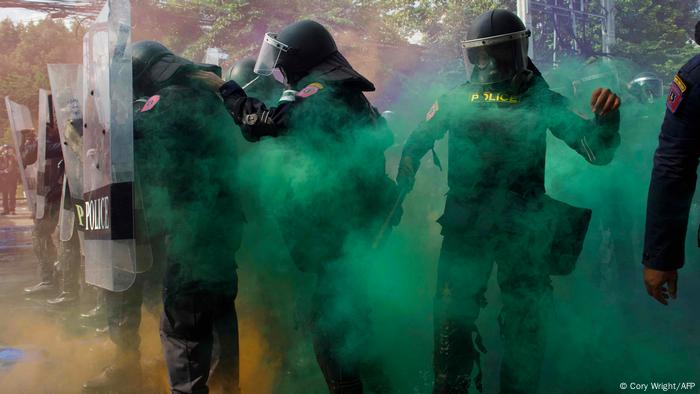Thailand: Dozens injured in violent protests
Pro-democracy activists and security forces have clashed once again in Bangkok, with police using tear gas and water cannons laced with irritating chemicals to stop protesters from entering the country's parliament.

Student-led pro-democracy protesters in Thailand clashed with police, who sought to keep them from entering the parliament premises on Tuesday.
At least 40 people were wounded, including five who were reportedly shot, according to emergency services. It was unclear who fired the shots and whether they were live rounds or rubber bullets.
"We tried to avoid clashes," Piya Tavichai, the deputy head of Bangkok police, told a news conference on Tuesday, adding that the police had tried to separate student protesters and the yellow-shirted royalist counter-protesters.
According to eyewitnesses, some people were injured during a brawl between pro-democracy protesters and stone-throwing royalists who oppose constitutional changes.
Read more: Thailand revokes emergency decree, protesters demand Prayuth resignation
Protesters in Thailand defy government order
Worst clashes in months
Tuesday's violence was the worst in months, as the Southeast Asian country's movement against the government of Prime Minister Prayuth Chan-ocha continues to gain strength.
Demonstrators have also been displaying their displeasure with Prayuth's government as they believe the party has an unfair grip on power.
The prime minister's parliamentary majority stems from the fact his junta picked the entire upper house before an election last year that opponents say was designed to keep him in power.
The protests, which began in July to demand former junta leader Prayuth's removal, have since manifested themselves to also call for reforms of Thailand's powerful monarchy.
Constitutional amendments or an attempt to buy time?
Thai lawmakers were scheduled to vote on seven proposed constitutional reforms during a two-day joint session of the elected House and appointed Senate. They adjourned a previous session without voting on proposed amendments, leading the pro-democracy protesters to accuse the government of acting in bad faith.
Read more: Thai parliament opens special session as protests continue
The protesters say the constitution, written and enacted under military rule, is undemocratic.
Experts say the parliamentary session is an effort by the government to take the initiative away from the pro-democracy movement, which also wants Prayuth and his government to step down.
Parliament is likely to establish a drafting committee to write a new charter. This would allow the government to say it is willing to meet the protesters' demands at least halfway, while buying time with a process that could extend over many months.
Read more:
Worst clashes in months
Tuesday's violence was the worst in months, as the Southeast Asian country's movement against the government of Prime Minister Prayuth Chan-ocha continues to gain strength.
Demonstrators have also been displaying their displeasure with Prayuth's government as they believe the party has an unfair grip on power.
The prime minister's parliamentary majority stems from the fact his junta picked the entire upper house before an election last year that opponents say was designed to keep him in power.
The protests, which began in July to demand former junta leader Prayuth's removal, have since manifested themselves to also call for reforms of Thailand's powerful monarchy.
Constitutional amendments or an attempt to buy time?
Thai lawmakers were scheduled to vote on seven proposed constitutional reforms during a two-day joint session of the elected House and appointed Senate. They adjourned a previous session without voting on proposed amendments, leading the pro-democracy protesters to accuse the government of acting in bad faith.
Read more: Thai parliament opens special session as protests continue
The protesters say the constitution, written and enacted under military rule, is undemocratic.
Experts say the parliamentary session is an effort by the government to take the initiative away from the pro-democracy movement, which also wants Prayuth and his government to step down.
Parliament is likely to establish a drafting committee to write a new charter. This would allow the government to say it is willing to meet the protesters' demands at least halfway, while buying time with a process that could extend over many months.
Read more:
Thai king's time in Bavaria draws growing scrutiny
shs/rs (dpa, Reuters, AP, AFP)
shs/rs (dpa, Reuters, AP, AFP)








